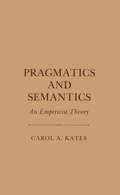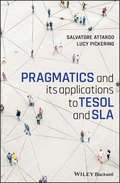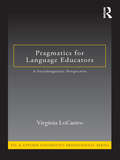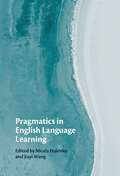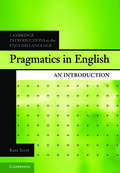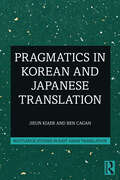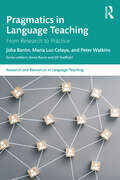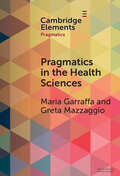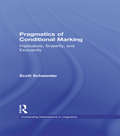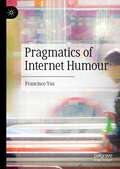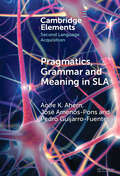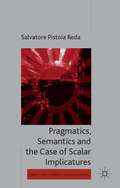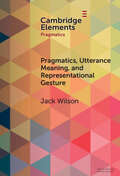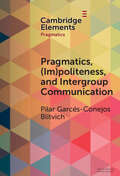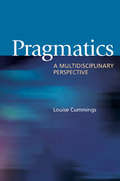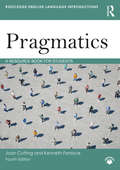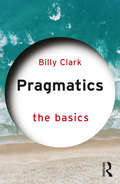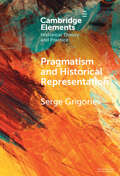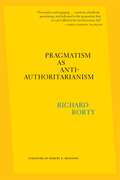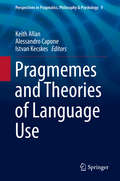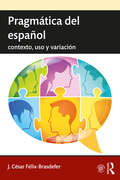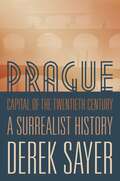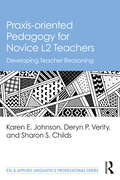- Table View
- List View
Pragmatics and Semantics: An Empiricist Theory
by Carol A. KatesWhat is the nature of communicative competence? Carol A. Kates addresses this crucial linguistic question, examining and finally rejecting the rationalistic theory proposed by Noam Chomsky and elaborated by Jerrold J. Katz, among others. She sets forth three reasons why the rationalistic model should be rejected: (1) it has not been supported by empirical tests; (2) it cannot accommodate the pragmatic relation between speaker and sign; and (3) the theory of universal grammar carries with it unacceptable metaphysical implications unless it is interpreted in light of empiricism. Kates proposes an empiricist model in place of the rationalistic theory—a model that, in her view, is more consistent with recent findings in linguistics and psycholinguistics. In attempting to clarify the nature of utterance meaning, Kates develops theoretical perspectives on phenomenological empiricism and produces an account of reference and intentionality directly relevant to empirically based theories of speaking and understanding. Among the major topics addressed in the book are transformational-generative and universal grammar, cognitive theories of language acquisition, pragmatic structure, predication and topic-comment structure, and empiricism and the philosophical problem of universals. An innovative and probing work, Pragmatics and Semantics: An Empiricist Theory will be welcomed by philosophers, linguists, and psycholinguists.
Pragmatics and its Applications to TESOL and SLA
by Salvatore Attardo Lucy PickeringA concise introduction to the field of theoretical pragmatics and its applications in second language acquisition and English-language instruction Pragmatics and its Applications to TESOL and SLA offers an in-depth description of key areas of linguistic pragmatics and a review of how those topics can be applied to pedagogy in the fields of second language acquisition (SLA) and teaching English to speakers of other languages (TESOL). This book is an excellent resource for students and professionals who have an interest in teaching pragmatics (speech acts, the cooperative principle, deixis, politeness theory, and more) in second language contexts. This book introduces technical terminology and concepts—including the fundamentals of semantics and semiotics—in simple language, and it provides illuminating examples, making it an excellent choice for readers with an elementary linguistics background who wish to further their knowledge of pragmatics. It also covers more advanced pragmatics topics, including stance, indexicality, and pragmatic appropriateness. Key features include: A comprehensive introduction to pragmatics, covering meaning, speech acts, the cooperation principle, politeness, metapragmatics, and more A unique orientation toward practical application in second language acquisition studies and English-language instruction Two-part chapters clearly separating theoretical introductions from concrete, real-world applications of the theory Thorough coverage that is accessible to both students and professionals currently teaching English to speakers of other languages, including sample lesson plans Practical chapters on the interface between pragmatics and teaching, and on research design Pragmatics and its Applications to TESOL and SLA is a comprehensive and coherent introduction, perfect for students, researchers, and scholars of pragmatics, second language acquisition, language teaching, and intercultural communication. It is also an excellent resource for professionals in the field of English-language education.
Pragmatics for Language Educators: A Sociolinguistic Perspective (ESL & Applied Linguistics Professional Series)
by Virginia LoCastroMaking pragmatics accessible to a wide range of students and instructors without dumbing down the content of the field, this text for language professionals: raises awareness and increases knowledge and understanding of how human beings use language in real situations to engage in social action fosters the ability to think critically about language data and use helps readers develop the ability to "do pragmatics" The book features careful explanations of topics and concepts that are often difficult for uninitiated readers, a wealth of examples, mostly of natural speech from collected data sources, and attention to the needs of readers who are non-native speakers of English, with non-Western perspectives offered when possible. Suggested Readings, Tasks, Discussion Questions, and Data Analysis sections involve readers in extending and applying what they are reading. The exercises push readers to recall and synthesize the content, elicit relevant personal experiences and other sources of information, and engage in changing their own interactional strategies. The activities go beyond a predictable framework to invite readers to carry out real life observations and experiment to make doing pragmatics a nonjudgmental everyday practice.
Pragmatics in English Language Learning
by Nicola Halenko Jiayi WangWritten by an international team of experts, this groundbreaking book explores the benefits and challenges of developing pragmatic competence in English as a target language, inside and outside the classroom, and among young and adult learners. The chapters present a range of first language contexts, including China, Germany, Indonesia, Italy, Mexico and Norway, to provide international perspectives on how different first languages present varying challenges for developing pragmatic awareness. The book outlines cutting-edge techniques for investigating spoken and written pragmatic competence, and offers practical teaching solutions, both face-to-face and online. It also examines underexplored areas of L2 pragmatics research, such as young learner groups, the effects of textbook materials, study abroad contexts and technology-mediated instruction and assessment. Innovative and comprehensive, this volume is a unique contribution to the field of L2 pragmatics, and will be essential reading for researchers, course developers, language teachers and students.
Pragmatics in English: An Introduction (Cambridge Introductions to the English Language)
by Kate ScottPragmatics – the study of language in context, and of how we understand what other people say – is a core subject in English language, linguistics, and communication studies. This textbook introduces the key topics in this fast-moving field, including metaphor, irony, politeness, disambiguation, and reference assignment. It walks the reader through the essential theories in pragmatics, including Grice, relevance theory, speech act theory, and politeness theory. Each chapter includes a range of illustrative examples, guiding readers from the basic principles to a thorough understanding of the topics. A dedicated chapter examines how research is conducted in pragmatics, providing students with resources and ideas for developing their own projects. Featuring exercises, a comprehensive glossary, and suggestions for further reading, this book is accessible to beginner undergraduates, including those with no prior knowledge of linguistics. It is an essential resource for courses in English language, English studies, and linguistics.
Pragmatics in Korean and Japanese Translation
by Jieun Kiaer Ben CaganThis book explores how the greater amount of pragmatic information encoded in Korean and Japanese can result in pragmatic (in)visibility when translating between those languages and English. Pragmatic information must be added when translating from English to Korean or Japanese and is easily lost when translating in the other direction. This book offers an analysis of translations in Japanese and Korean of Harry Potter and the Philosopher’s Stone and The Hobbit, or There and Back Again to show how the translated versions crystallise the translators’ interpretations of relationships in the way characters address one another. This book discusses fan translations of Korean and Japanese to English of various popular media, observing that the emotional meanings easily lost when translating in this direction are often deemed important enough to warrant the insertion of additional explanatory material. The book additionally discusses the role of fan translation in the construction of international online communities and a heightened communal commentary on translation. Western translation commentary has historically lacked sufficient emphasis on translation to and from East Asian languages, and these case studies help to address a problem of central importance to translation to and from languages that encode interpersonal dynamics in dramatically different ways to English. This book will be of interest to students and researchers in translation studies, particularly in Korean and Japanese translation. The book will also appeal to students and researchers of the Korean and Japanese languages.
Pragmatics in Language Teaching: From Research to Practice (Research and Resources in Language Teaching)
by Peter Watkins Júlia Barón María Luz CelayaThis innovative book links theory to practice with regard to teaching pragmatics. In laying out why this is useful, how it is achievable, and what to teach when it comes to pragmatics, this book outlines the theoretical background and offers a wide range of hands-on activities. While offering coverage of timely issues like pragmatics in text messaging, the authors expertly provide further guidance for developing pragmatics curricula for learners of different ages and languages, and at different proficiency levels in a research-based, practical way. This reader-friendly resource gives pre- and in-service FL/L2 teachers the tools and confidence to understand and implement these principles in the classroom and beyond. Advanced students and researchers of applied linguistics, education, and psychology, as well as curriculum developers, teacher trainers, and aspiring teachers around the world – and their students – will benefit from this unique book.
Pragmatics in the Health Sciences (Elements in Pragmatics)
by Maria Garraffa Greta MazzaggioThis Element aims to address a gap in the literature at the intersection of linguistics, particularly pragmatics, and health sciences, such as speech and language pathology. The first section introduces the application of pragmatics concepts in healthcare and neuroscience. Section 2 discusses the development of pragmatic abilities in childhood, focusing on pragmatic communication disorder. Section 3 reviews studies on pragmatic abilities in adolescents, adults, and clinical populations, including assessments of pragmatic skills in ageing. Section 4 broadens the scope by exploring pragmatic impairments in new populations. The final section reflects on the importance of pragmatics in healthcare practice, introducing studies on mental health and intercultural pragmatics. Each section proposes discussion points to contextualise the research within debates on health pragmatics. The Element also includes a glossary (available as online supplementary material) to assist interdisciplinary audiences in understanding clinical pragmatics terminology.
Pragmatics of Conditional Marking: Implicature, Scalarity, and Exclusivity (Outstanding Dissertations in Linguistics)
by Scott SchwenterFirst Published in 1999. Routledge is an imprint of Taylor & Francis, an informa company.
Pragmatics of Internet Humour
by Francisco YusThis book provides a first thorough analysis of internet humour from a cognitive-pragmatic perspective, covering a wide range of discourses that are pervasive online and focusing especially on messaging interactions, social networking sites and memes. Its chapters describe the inferential strategies implemented to turn online coded discourses into meaningful interpretations, which in turn can be devised and manipulated for the sake of humour. Furthermore, and apart from the typical object of pragmatic research (humorous discourses), the book emphasises the importance of the interfaces’ design and of the qualities of the users engaged in humorous interactions (called contextual constraints), additionally highlighting the parallel significance of the various effects, shaped as feelings and emotions, that stem from humorous communication on the internet. In sum, the book delivers a rich and detailed account of humorous internet discourses through dissecting their affordances as a medium, tracking the users’ intentions, and predicting the audiences’ interpretive strategies, with the goal of helping the reader obtain a better understanding of internet humour and its role in today’s online interactions.
Pragmatics, Grammar and Meaning in SLA (Elements in Second Language Acquisition)
by Aoife K. Ahern José Amenós-Pons Pedro Guijarro-FuentesThis Element explores the role of pragmatics, and its relationship with meaning and grammar, in second language acquisition. Specifically, this Element examines the generative paradigm, with its focus on purely linguistic aspects, in contrast with, and complemented by, the view of language adopted in the wider perspective on communication that Relevance Theory offers. It reviews several theoretical standpoints on how linguistic phenomena that require combining semantic, pragmatic and syntactic information are acquired and developed in second languages, illustrating how these perspectives are brought together in analysing data in different linguistic scenarios. It shows that the notion of procedural meaning casts light on the range of interpretative effects of grammatical features and how they vary across languages, suggesting ways to complete the picture of the interface factors that affect second language development.
Pragmatics, Semantics And The Case Of Scalar Implicatures
by Salvatore Pistoia RedaThis book is an advanced debate on the nature of scalar implicatures, one of the most popular topics in philosophical linguistics in the last 20 years. Leading theorists in the field offer an up-to-date presentation of the subject in a way that will help readers to orient themselves in the vast literature on the topic.
Pragmatics, Utterance Meaning, and Representational Gesture (Elements in Pragmatics)
by Jack WilsonHumans produce utterances intentionally. Visible bodily action, or gesture, has long been acknowledged as part of the broader activity of speaking, but it is only recently that the role of gesture during utterance production and comprehension has been the focus of investigation. If we are to understand the role of gesture in communication, we must answer the following questions: Do gestures communicate? Do people produce gestures with an intention to communicate? This Element argues that the answer to both these questions is yes. Gestures are (or can be) communicative in all the ways language is. This Element arrives at this conclusion on the basis that communication involves prediction. Communicators predict the behaviours of themselves and others, and such predictions guide the production and comprehension of utterance. This Element uses evidence from experimental and neuroscientific studies to argue that people produce gestures because doing so improves such predictions.
Pragmatics,: A Multilayered, Discursive Analysis of Cancel Culture (Elements in Pragmatics)
by Pilar G. BlitvichThis Element shows the basis for pragmatics/(im)politeness to become intergroup-oriented to be able to consider interactions in which social identities are salient or are essentially collective in nature, such as Cancel Culture (CC). CC is a form of ostracism involving the collective withdrawal of support and concomitant group exclusion of individuals perceived as having behaved in ways construed as immoral and thus displaying disdain for group normativity. To analyze this type of collective phenomenon, a three-layered model that tackles CC manifestations at the macro, meso, and micro levels is used. At the meso/micro levels, problematize extant conceptualizations of CC -mostly focused on the macro level and describe it as a Big C Conversation, whose meso-level practices need to be understood as genre-ecology, and where identity reduction, im/politeness, and moral emotions synergies are key to understand group entitativity and agency.
Pragmatics: A Multidisciplinary Perspective (Perspectives In Pragmatics, Philosophy And Psychology Ser. #3)
by Louise CummingsThe first truly multidisciplinary text of its kind, this book offers an original analysis of the current state of linguistic pragmatics. Cummings argues that no study of pragmatics can reasonably neglect the historical and contemporary influences on this discipline of neighboring fields of inquiry, particularly philosophy, psychology, artificial intelligence, and language pathology. By the same token, these fields can begin to address their own questions more productively by examining the insights of pragmatics. The book's range of topics and depth of analysis will be of interest to advanced undergraduate and more specialized readers in linguistics, communication studies, speech and language therapy, and cognitive science. Topics discussed include:*coverage of pragmatic concepts and theories;*criticisms of Sperber and Wilson's relevance theory, Habermas's theory of communicative competence, and Kasher's views on the modularity of pragmatics;*pragmatic deficits in a range of child and adult language disorders; and*a pragmatic analysis of argumentation in topical issues such as AIDS and BSE theories of meaning, inferences, pragmatics and AI.
Pragmatics: A Resource Book for Students (Routledge English Language Introductions)
by Joan Cutting Kenneth FordyceRoutledge English Language Introductions cover core areas of language study and are one-stop resources for students. Assuming no prior knowledge, books in the series offer an accessible overview of the subject, with activities, study questions, sample analyses, commentaries, and key readings – all in the same volume. The innovative and flexible ‘two-dimensional’ structure is built around four sections – introduction, development, exploration, and extension – that offer self-contained stages for study. Each topic can also be read across these sections, enabling the reader to gradually build on the knowledge gained. Now in its fourth edition, this best-selling textbook: Covers the core areas of the subject: speech acts, the cooperative principle, relevance theory, corpus pragmatics, politeness theory, and critical discourse analysis Has updated and new sections on intercultural and cross-cultural pragmatics, critical discourse analysis and the pragmatics of power, second language pragmatic competence development, impoliteness, post-truth discourse, vague language, pragmatic markers, formulaic sequences, and online corpus tools Draws on a wealth of texts in a variety of languages, including political TV interviews, newspaper articles, extracts from classic novels and plays, recent international films, humorous narratives, and exchanges on email, messaging, Facebook, Twitter, and WhatsApp Provides recent readings from leading scholars in the discipline, including Jonathan Culpeper, Lynne Flowerdew, and César Félix-Brasdefer Is accompanied by eResources featuring extra material and activities. Written by two experienced teachers and researchers, this accessible textbook is an essential resource for all students of English language and linguistics.
Pragmatics: The Basics (The Basics)
by Billy ClarkPragmatics: The Basics is an accessible and engaging introduction to the study of verbal and nonverbal communication in context. Including nine chapters on the history of pragmatics, current theories, the application of pragmatics, and possible future developments in the field, this book: Offers a comprehensive overview of key ideas in contemporary pragmatics and how these have developed from and beyond the pioneering work of the philosopher Paul Grice; Draws on real-world examples such as political campaign posters and song lyrics to demonstrate how we convey and understand direct and indirect meanings; Explains the effects of verbal, nonverbal, and multimodal communication and how the same words or behaviour can mean different things in different contexts, including what makes utterances more or less polite; Highlights key terms and concepts throughout and provides chapter-end study questions, further reading suggestions, and a glossary. Written by an experienced researcher and teacher, this book will be an essential introduction to this topic for all beginning students of English Language and Linguistics.
Pragmatism and Historical Representation (Elements in Historical Theory and Practice)
by Serge GrigorievNo prominent pragmatist philosopher to date has offered us a fully developed theory of history or historical interpretation. Nevertheless, a number of pivotal arguments and suggestions made by the pragmatists appeared to many both insightful and pertinent enough to offer a distinctive promise of a cohesive and distinctive general pragmatist perspective in historical theory. The present contribution is intended to secure some advances in this direction, focusing on the relationships between objectivity and perspective; between representation as an accurate correspondence to reality and the social, cultural sense of representation as being represented and being representative; as well as the relationship between individualizing comprehension and generalizing abstraction in historical contexts.
Pragmatism and Poetic Agency: The Persistence of Humanism (Routledge Research in American Literature and Culture)
by Ulf SchulenbergPragmatism is a humanist philosophy. In spite of the much-debated renaissance of pragmatism, however, a detailed discussion of the relationship between pragmatism and humanism is still a desideratum. It is difficult to understand the complexity of pragmatism without considering the significance of humanism. At least since the 1970s, humanism, mostly in its liberal version, has been vehemently attacked and criticized. In pragmatism, however, a particular understanding of humanism has persisted. Bringing literary studies, philosophy, and intellectual history together and establishing a transatlantic theoretical dialogue, Pragmatism and Poetic Agency endeavors to elucidate this persistence of humanism. Schulenberg continues the thought-provoking argument he developed in his previous two monographs by advancing the idea that one can only grasp the unique contemporary significance of pragmatism when one realizes how pragmatism, humanism, anti-authoritarianism, and postmetaphysics are interlinked. If one appreciates the implications and consequences of this link, then one is in a position to see pragmatism’s antifoundationalist and antirepresentationalist story of progress and emancipation as continuing the project of the Enlightenment.
Pragmatism as Anti-Authoritarianism
by Richard RortyThe last book by the eminent American philosopher and public intellectual Richard Rorty, providing the definitive statement of his mature philosophical and political views. Richard Rorty’s Pragmatism as Anti-Authoritarianism is a last statement by one of America’s foremost philosophers. Here Rorty offers his culminating thoughts on the influential version of pragmatism he began to articulate decades ago in his groundbreaking Philosophy and the Mirror of Nature. Marking a new stage in the evolution of his thought, Rorty’s final masterwork identifies anti-authoritarianism as the principal impulse and virtue of pragmatism. Anti-authoritarianism, on this view, means acknowledging that our cultural inheritance is always open to revision because no authority exists to ascertain the truth, once and for all. If we cannot rely on the unshakable certainties of God or nature, then all we have left to go on—and argue with—are the opinions and ideas of our fellow humans. The test of these ideas, Rorty suggests, is relatively simple: Do they work? Do they produce the peace, freedom, and happiness we desire? To achieve this enlightened pragmatism is not easy, though. Pragmatism demands trust. Pragmatism demands that we think and care about what others think and care about, which further requires that we account for others’ doubts of and objections to our own beliefs. After all, our own beliefs are as contestable as anyone else’s. A supple mind who draws on theorists from John Stuart Mill to Annette Baier, Rorty nonetheless is always an apostle of the concrete. No book offers a more accessible account of Rorty’s utopia of pragmatism, just as no philosopher has more eloquently challenged the hidebound traditions arrayed against the goals of social justice.
Pragmemes and Theories of Language Use
by Keith Allan Alessandro Capone Istvan KecskesThis volume offers recent developments in pragmatics and adjacent territories of investigation, including important new concepts such as the pragmatic act and the pragmeme, and combines developments in neighboring disciplines in an integrative holistic pragmatic approach. The young science of pragmatics has, from its inception, differentiated itself from neighboring fields in the humanities, especially the disciplines dealing with language and those focusing on the social and anthropological aspects of human behavior, by focusing on the language user in his or her societal environment. This collection of papers continues that emphasis on language use, and pragmatic acts in their context. The editors and contributors share a perspective that essentially considers language as a system for communication and wants to look at language from a societal perspective, and accept the view that acts of interpretation are essentially embedded in culture. In an interdisciplinary approach, some authors explore connections with social theory, in particular sociology or socio-linguistics, some offer a political stance (critical discourse analysis), others explore connections with philosophy and philosophy of language, and several papers address problems in theoretical pragmatics.
Pragmática del español: contexto, uso y variación
by J. César Félix-BrasdeferPragmática del español introduces the central topics in pragmatics and discourse from a sociolinguistic perspective. Pragmatic variation is addressed within each topic, with examples from different varieties of Spanish spoken in Latin America, Spain and the United States. A companion website provides additional exercises and a corpus of Spanish data for student research projects. A sample syllabus and suggestions for further reading help instructors tailor the material to a one-semester course or as a supplement to general introduction to Hispanic linguistics courses. This is an ideal resource for advanced undergraduate and postgraduate students, at level B2 – C2 of the Common European Framework for Languages, and Intermediate High – Advanced High on the ACTFL proficiency scales.
Prague, Capital of the Twentieth Century: A Surrealist History
by Derek SayerThe story of modernity told through a cultural history of twentieth-century PragueSetting out to recover the roots of modernity in the boulevards, interiors, and arcades of the "city of light," Walter Benjamin dubbed Paris "the capital of the nineteenth century." In this eagerly anticipated sequel to his acclaimed Coasts of Bohemia: A Czech History, Derek Sayer argues that Prague could well be seen as the capital of the much darker twentieth century. Ranging across twentieth-century Prague's astonishingly vibrant and always surprising human landscape, this richly illustrated cultural history describes how the city has experienced (and suffered) more ways of being modern than perhaps any other metropolis.Located at the crossroads of struggles between democratic, communist, and fascist visions of the modern world, twentieth-century Prague witnessed revolutions and invasions, national liberation and ethnic cleansing, the Holocaust, show trials, and snuffed-out dreams of "socialism with a human face." Yet between the wars, when Prague was the capital of Europe's most easterly parliamentary democracy, it was also a hotbed of artistic and architectural modernism, and a center of surrealism second only to Paris.Focusing on these years, Sayer explores Prague's spectacular modern buildings, monuments, paintings, books, films, operas, exhibitions, and much more. A place where the utopian fantasies of the century repeatedly unraveled, Prague was tailor-made for surrealist André Breton's "black humor," and Sayer discusses the way the city produced unrivaled connoisseurs of grim comedy, from Franz Kafka and Jaroslav Hasek to Milan Kundera and Václav Havel. A masterful and unforgettable account of a city where an idling flaneur could just as easily be a secret policeman, this book vividly shows why Prague can teach us so much about the twentieth century and what made us who we are.
Praktische handleiding PubMed
by R. Deurenberg F.S. van Etten-JamaludinDe 1ste Nederlandse gids die op overzichtelijke wijze op de uitgebreide mogelijkheden van PubMed ingaat. Korte heldere hoofdstukken met de volgende onderwerpen: hoe formuleer ik een goede zoekvraag? op welke manier kan ik in PubMed zoeken? hoek kan ik zoekresultaten vergroten of verkleinen
Praxis-oriented Pedagogy for Novice L2 Teachers: Developing Teacher Reasoning (ESL & Applied Linguistics Professional Series)
by Karen E. Johnson Deryn P. Verity Sharon S. ChildsIn this cutting-edge book on L2 teacher education, experts Johnson, Verity, and Childs demonstrate how praxis-oriented pedagogy grounded in the principles of Vygotskian Sociocultural Theory (VSCT) can have a meaningful impact on L2 teachers’ development. Starting with a clear definition of praxis-oriented pedagogy, the authors lay out a theoretical foundation and document how appropriately designed praxis-oriented L2 teacher education pedagogy supports the development of novice teacher reasoning. Drawing from a longitudinal study of L2 novice teachers, chapters address teachers’ understanding, learning, and cognitive development and how their capabilities grow in creating and implementing engaging language learning environments for their ESL students. At the core of the book lies a unique set of pedagogical concepts: linguistically compact, conceptually rich chunks of language that function as psychological tools for learning and teaching. By covering teachers’ changes in understanding, reasoning, and pedagogical activities, the book reveals the role that pedagogical concepts play in praxis-oriented pedagogy. Essential reading for language teacher educators, language teachers, and researchers, this book makes the VSCT principles that inform praxis-oriented pedagogy both clear and accessible.
